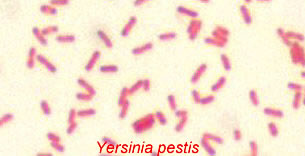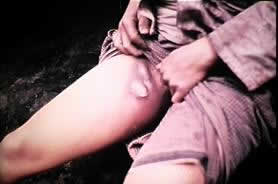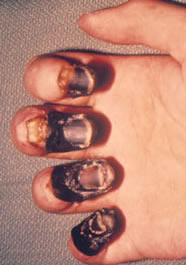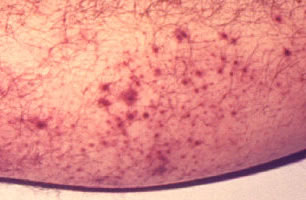Plague
Background and potential
as a bioweapon
 Historically,
episodes of plague have killed large percentages of human populations. Tens
of millions of people have died in Europe due to plague. Plague is caused by
the colonization of a mammalian host by the bacterium Yersinia pestis.
Yersinia pestis is efficiently transferred between hosts by fleas. Fleas
move freely from host to host innoculating each with the bacteria.
Historically,
episodes of plague have killed large percentages of human populations. Tens
of millions of people have died in Europe due to plague. Plague is caused by
the colonization of a mammalian host by the bacterium Yersinia pestis.
Yersinia pestis is efficiently transferred between hosts by fleas. Fleas
move freely from host to host innoculating each with the bacteria.
During the Middle Ages,
flea-infested rats often inhabited homes and work sites Any mammal including
man can serve as a food source for fleas. Today, wild rodents in some areas
of the world continue to be infected with plague. Outbreaks are usually associated
with infected rats and rat fleas that live in the home. In the United States,
the last urban plague epidemic occurred in Los Angeles in 1924-25. Since then,
there have been approximately 10 to 15 persons infected each year, primarily
in rural areas. Most human cases in the U.S. occur in northern New Mexico, northern
Arizona, and southern Colorado, and in California, southern Oregon and western
Nevada. Plague also exists in Africa, Asia, and South America. The World Health
Organization reports 1,000 to 3,000 cases of plague each year.
Until World War II plague
was a naturally occuring disease. The Chinese were the first to experience plague
as a biologic weapon. In WWII a Japanese secret project bred human fleas, infected
them with the plague and unleashed them on the civilian chinese population in
a number of major metropolitan areas. Thousands died and panic resulted just
as was intended. Since then, improvements in the dissemination of plague has
been studied by a number of countries, including the USA. In 1972 the USA signed
the Biological Weapons Convention, vowing never to use biological weapons.
Aerosolization of the plague
bacteria has been found to be the most effective means of delivery. Aerosolization
can cause large numbers of casualties from pulmonary disease several days after
dispersal. The natural lag time between dispersal and symptoms of the disease
make it an attractive terrorist weapon. Optimum circumstances for dispersal
include:
- dense population
- cover of night
- cool, humid, still air.
Epidemiology
 Plague
is an infectious disease of animals and humans caused by the bacterium Yersinia
pestis. The primary reservoir may be soil, where it can persist for years. Burrowing animals may be the first link in the chain of transmission to humans. Humans usually contract plague by being bitten by an infected rodent
flea or by handling an infected animal. Droplet transmission and intentional aerosol are additional routes. Yersinia pestis is easily destroyed by sunlight and drying. However,
when released into air, the bacterium can survive for up to one hour, depending
on weather conditions.
Plague
is an infectious disease of animals and humans caused by the bacterium Yersinia
pestis. The primary reservoir may be soil, where it can persist for years. Burrowing animals may be the first link in the chain of transmission to humans. Humans usually contract plague by being bitten by an infected rodent
flea or by handling an infected animal. Droplet transmission and intentional aerosol are additional routes. Yersinia pestis is easily destroyed by sunlight and drying. However,
when released into air, the bacterium can survive for up to one hour, depending
on weather conditions.
There are 4 primary forms of plague:
bubonic, pharyngeal, pneumonic, and septicemic.
- Bubonic plague results when Yersinia
pestis enters through a break in the skin, e.g., infected flea bites, infected animal bites or scratches, infectious material contact with non-intact skin. Bubonic plague does not spread from
person to person.
- Pharnygeal plague is rare, but has been documented in persons who have consumed both cooked and raw contaminated camel meat.
- Pneumonic plague occurs
when the plague bacterium infects the lungs. This type of plague can spread
via an airborne route from animal to person, person to person. Studies indicate that droplet transmission does not usually occur over distances beyond 3.7 feet. However, Yersinia pestis can be intentionally aerosolized, as in a terrorist attack. Untreated
pneumonic plague is rapidly fatal. Pneumonic plague may also occur if a person
with other forms of plague is not treated and the bacteria spread to the lungs.
- Septicemic plague occurs
when plague bacteria multiply in the blood. It can occur as a complication
of pneumonic or bubonic plague, or it can occur by itself. Septicemic plague
does not spread from person to person.
INSTANT
FEEDBACK:
Pneumonic
plague can spread from person to person.
Clinical course
Patients with bubonic plague
develop fever, headache, chills, weakness and swollen tender lymph glands, known
as buboes. Buboes are very painful, usually swollen, and often hot-to-the touch.
Buboes and a history of exposure to rodents, rodent fleas, wild rabbits, or
sick or dead carnivores should lead to suspicion of plague.
Onset of bubonic plague is usually 2 to 6 days after a person is exposed. Occasionally,
buboes cannot be detected for a day or so after the onset of other symptoms.
The disease progresses rapidly and the bacteria can invade the bloodstream,
producing severe illness, called plague septicemia.
Once a human is infected, a progressive and potentially fatal illness generally
results unless specific antibiotic therapy is given. Progression leads to blood
infection and, finally, to lung infection. The infection of the lung is termed
plague pneumonia, and it can be transmitted to others through the expulsion
of infective respiratory droplets by coughing.
While bubonic plague is
the most common form of the disease in nature, bioterrorists could
aerosolize the bacteria to cause pneumonic plague. The incubation period is
1 to 4 days. The first signs of pneumonic plague are fever, headache, weakness,
and rapidly developing pneumonia with shortness of breath, cough, hemoptosis
and chest pain. The pneumonia progresses for 2 to 4 days and may produce respiratory
failure and shock. Without early treatment (24 hours), patients will die. Pneumonic plague is virtually 100% fatal without early antibiosis.
The symptoms of
septicemic plague are fever, chills, prostration, abdominal pain, shock, and
bleeding into the skin and other organs. Patients with septicemic plague do
not develop the buboes that characterize bubonic plague.
 |
 |
 |
|
Femoral Bubo |
Gangrene for which
the "Black Death" was named. |
Subcutaneous
hemorrhage |
Disease Management
|
Droplet transmission,
Droplets are generated during coughing, sneezing, and talking. Droplets
do not remain suspended in the air, special air handling and ventilation
are not required to prevent droplet transmission. Certain procedures such
as suctioning, bronchoscopy, sawing, drilling etc. should be avoided if
possible. Respirators and PPEs authorized for use as protection from TB
should be used. |
Antibiotics used as traditional treatment options (eg, streptomycin, tetracycline, chloramphenicol) were less active than ceftriaxone, ciprofloxacin, ofloxacin, and ampicillin, against known variants of Yersinia pestis. Antibiotics must be started ASAP. To prevent death from pneumonic plague they must be started within 24 hours of the first
symptoms. Pneumonic plague is highly contagious. Both standard and droplet precautions
should be used. Antibiotic therapy for 7 days will likely protect care givers
and family who have direct contact with infected patients.
In the event of mass exposure,
patients should be organized by cohort for isolation and treatment. Patient
transport and isolation precautions should be as for TB. A plague vaccine is
not currently available for use in the U.S.
Lastly, following an aerosol
attack, the disease could persist in locales for long periods by taking residence
in the soil and domestic and wild animal populations. Extermination activities may be needed
to control vector and disease resevoirs.
A licensed Yersinia pestis vaccine does exist and was available in the U.S. until 1999 when the sole manufacturer discontinued production. Other vaccines are available outside the U.S. and research continues on new forms.
Public Health
Plague is a reportable disease. Suspect or confirmed cases must be reported to public health authorities as soon as possible, according to disease-reporting rules within each state or local jurisdiction.
INSTANT
FEEDBACK:
The
first symptoms of pneumonic plague are fever, weakness, headache, and rapidly
developing pneumonia with shortness of breath, cough, hemoptosis and chest pain.
©RnCeus.com
 Historically,
episodes of plague have killed large percentages of human populations. Tens
of millions of people have died in Europe due to plague. Plague is caused by
the colonization of a mammalian host by the bacterium Yersinia pestis.
Yersinia pestis is efficiently transferred between hosts by fleas. Fleas
move freely from host to host innoculating each with the bacteria.
Historically,
episodes of plague have killed large percentages of human populations. Tens
of millions of people have died in Europe due to plague. Plague is caused by
the colonization of a mammalian host by the bacterium Yersinia pestis.
Yersinia pestis is efficiently transferred between hosts by fleas. Fleas
move freely from host to host innoculating each with the bacteria.  Plague
is an infectious disease of animals and humans caused by the bacterium Yersinia
pestis. The primary reservoir may be soil, where it can persist for years. Burrowing animals may be the first link in the chain of transmission to humans. Humans usually contract plague by being bitten by an infected rodent
flea or by handling an infected animal. Droplet transmission and intentional aerosol are additional routes. Yersinia pestis is easily destroyed by sunlight and drying. However,
when released into air, the bacterium can survive for up to one hour, depending
on weather conditions.
Plague
is an infectious disease of animals and humans caused by the bacterium Yersinia
pestis. The primary reservoir may be soil, where it can persist for years. Burrowing animals may be the first link in the chain of transmission to humans. Humans usually contract plague by being bitten by an infected rodent
flea or by handling an infected animal. Droplet transmission and intentional aerosol are additional routes. Yersinia pestis is easily destroyed by sunlight and drying. However,
when released into air, the bacterium can survive for up to one hour, depending
on weather conditions. 

